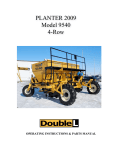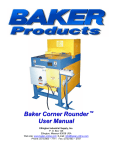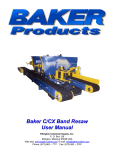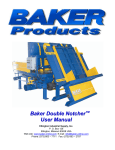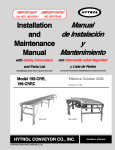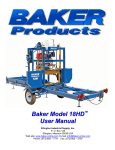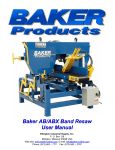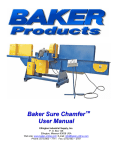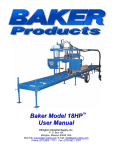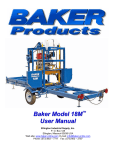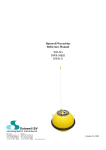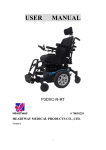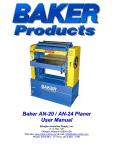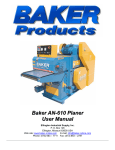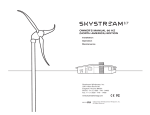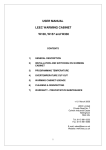Download Baker M6 Sidewinder DeDuster User Manual
Transcript
66 Equipment Photo TM Baker M6 Sidewinder DeDuster User Manual Ellington Industrial Supply, Inc. P. O. Box 128 Ellington, Missouri 63638 USA Web site: www.baker-online.com E-mail: [email protected] Phone: (573) 663 – 7711 Fax: (573) 663 – 2787 TABLE OF CONTENTS 1 2 3 4 5 6 7 INTRODUCTION Machine Purpose Machine Function Definition of Terms Manual Contents Notice Machine Specifications and Requirements Warranty Defective Parts Service Policy RULES FOR SAFE OPERATION Safety Expectations for Operating Power Equipment Control of Hazardous Energy – (Lockout / Tagout) Machine Safety Decals MACHINE FEATURES SET-UP Receiving and Inspection Unpacking Machine Positioning Power and Utilities Requirements Operator Training OPERATION Operator Control Station Adjusting for Material Width and Length Adjusting Brush Height To Begin Processing Material MAINTENANCE General Clean Up Inspection and Preventative Maintenance Checklist Replacing Brushes Air Assembly De-Duster Chamber Access Hatch PARTS AND SERVICE Service Contact Information Serial Number Location Baker M6 DeDuster - Rev 1, 11/07; WWW.BAKER-ONLINE.COM 2 3 3 3 4 5 5 6 7 7 8 8 9 10 11 12 12 12 12 12 13 14 14 15 16-17 18 19 19 19-21 22 23 24 25-26 27 27 INTRODUCTION Thank you and congratulations on the purchase of your new Baker M6 Sidewinder DeDuster. It has been designed to be durable, productive and easy to use. When properly ran and maintained, it will provide you with many years of profitable operation. For safety reasons, and for your own best use of the Baker M6 Sidewinder DeDuster, we insist that you read this manual fully, and constantly review and refer back to it as necessary. No one should attempt to operate or perform maintenance on this equipment until they have taken the time to read and understand the information contained in this manual. ** FAILING TO DO SO MAY RESULT IN SERIOUS INJURY ** Machine Purpose The Baker M6 DeDuster was designed and manufactured for high production, capable of running 140 linear feet per minute. Machine Function Your Baker M6 Sidewinder DeDuster features a non-slip board infeed, chain drive feed through and two industrial size spherical nylon brushes that spin across the board surface for maximum dust, particle and chip removal. Baker M6 DeDuster - Rev 1, 11/07; WWW.BAKER-ONLINE.COM 3 Definition of Terms All Stop Safety button (typically “red”) designed to immediately shut-down machine operation Board Foot or Board Feet A form of measurement where one board foot equals the volume of a board 1 inch thick by 12 inches wide and 12 inches long (1” x 12” x 12” = 1 board foot) CFM (cubic feet per minute) A measure of the volume of a substance flowing through air within a fixed period of time Conveyor A mechanical apparatus (typically a belt, chain or rollers) that transports material from one place to another Edge Guide A straight edge that is used to guide a piece of material End Stop A mechanism designed to stop the progress of an off-loading board Fence (Arm) A straight guide used to keep a log, cant or board a set distance from a blade or cutter Infeed The side of the machine where the work piece (stringer, board, etc.) enters Lift Point A point where pressure can and should be applied for lifting Linear Foot A system of measurement in which only the length of the lumber is considered. Live Rollers A powered roll case that mechanically moves material Lockout / Tagout Requires authorized employee(s) to lock and tag the energy-isolating device(s) to prevent the release of hazardous energy in order to prevent injury to employees, normally while performing maintenance or repairs Lumber (board) A longitudinal section of a log after the wany edges have been removed, normally a 4-sided rectangular shaped piece Off-load The side of a machine where the work piece (stringer, board, etc.) exits Production Rate A produced or processed quantity measure with respect to another measured quantity of time; for example number of boards per minute, board feet per hour, per day, per week, etc. Schematic A structural or procedural diagram, typically of an electrical or hydraulic system Yield To generate a return for effort, an amount produced Baker M6 DeDuster - Rev 1, 11/07; WWW.BAKER-ONLINE.COM 4 Manual Contents Notice This manual is not totally comprehensive. It does not and cannot convey every possible safety and operational problem that may arise while using this machine. The manual will cover many of the basic and specific safety procedures needed in an industrial environment. All federal and state laws and any regulations having jurisdiction covering the safety requirements for use of this machine take precedence over the statements in this manual. Users of this machine must adhere to such regulations. Machine Specifications and Requirements Power • (Three) 1 HP (.75 kw) TEFC Motors • (One) 2 HP (1.49 kw) TEFC Motor Dimensions & Weight Length: 93” (236 cm) Width: 98” (249 cm) Height: 51” (129.5 cm) Operating Air Pressure • 45 psi (13mm) • 1/2”, 120 psi incoming air Weight: 2,440 lbs (1,107kg) pressure required Production Rate • Feed speed 140 linear feet per minute Sawdust Removal • 6” (152mm) outlet; min. 1,500 CFM suction recommended at dust removal chute Capacity Material Size: • Board width: 3 ½” – 6” • Board height: Max 2” • Board length: Min – 28” • Board length: Max – 62” Baker M6 DeDuster - Rev 1, 11/07; WWW.BAKER-ONLINE.COM 5 Warranty Ellington Industrial Supply, Inc. machinery is warranted against defects in material or workmanship starting from the date of shipment from the manufacturing plant. This warranty is given solely to the “original purchaser” of the equipment and is in no way to be expressed or implied that it is transferable to any other parties without the written consent and approval from the CEO or Sales Manager of Baker Products. Our one (1) year warranty period covers all items built at our manufacturing facilities including structural frame, cowlings, doors, shafting, dust chutes and guards. We honor six (6) months of warranty coverage for miscellaneous vendor-purchasedsupplied items including bearings, chain, sprockets, hydraulic components, etc. Ninety (90) days of warranty coverage is provided on all electrical parts. All electrical components and wiring has been installed in accordance with the National Electrical Code (NEC) of the United States of America. Thirty (30) days of warranty coverage is provided for De-Duster brushes, which are considered a wearable and consumable item. Ellington Industrial Supply, Inc. does not warranty this machine to meet any other requirements or jurisdiction of any electrical or safety codes of any other state, municipality, other country or jurisdiction The purchaser assumes all risk and liability whatsoever resulting from the use thereof whether used singularly or in conjunction with other machinery or apparatus, including, but not limited to, all matters resulting from sawdust generation. Note: No warranty is provided on any electrical components or parts if equipment is powered or connected to a roto-phase electrical converter in order to create a three phase power supply for operational current from a single phase source. Any change in materials, design, or performance intended to improve any product of Ellington Industrial Supply, Inc. shall not obligate Ellington Industrial Supply, Inc. to modify any previously manufactured equipment. This manual may contain details that if not properly followed can affect the performance of your equipment. You are responsible for proper use and maintenance of your equipment and we reserve the right to deny warranty work if deemed to be caused by a lack of proper maintenance or negligence by the owner or any of their employees. Baker M6 DeDuster - Rev 1; 11/07 WWW.BAKER-ONLINE.COM 6 Defective Parts Parts claimed defective must be returned freight prepaid, to our plant in Ellington, Missouri. Any part determined defective due to faulty workmanship or materials will be replaced or repaired (at our option) free of charge, F.O.B. our plant. This warranty does not cover expendable items (i.e. drive belts, index-able cutter head inserts, chip breakers, wedge blocks or mounting hardware, etc.). Except as expressly provided herein, this warranty is in lieu of all other warranties, expressed or implied, including a warranty of merchantability or fitness for a particular purpose. This warranty is “void” if any part of the unit has been tampered with, modified, altered, or operated with parts other than supplied or recommended by Ellington Industrial Supply, Inc. In no event shall Ellington Industrial Supply, Inc. be liable for special, indirect, incidental or consequential damages, however arising, including but not limited to, the loss of earnings or the cost of downtime. Service Policy In the event that you have any problems, call us at (573) 663-7711 any time between 8:00 AM and 5:00 PM (CST), Monday through Friday. A member of our trained staff will answer any questions you may have. We charge nothing for this service. The only charge is for replacement parts not covered by warranty or after our inspection we deem that the problem is due to operator error or lack of proper maintenance or neglect. If it is necessary for a member of our service department to visit your plant at your request, there will be a charge for this service. Call our service department for current prices. Retain this Information for your Records Model Number: ………………………………………...…………………………. Serial Number: ……………………………………………………………………. Date of Purchase: ………………………………………………………………… Power Source:…………..…………………….…………………………………… Dust Removal: ….……………………………………………………………….… Ellington Industrial Supply, Inc. P. O. Box 128 Ellington, Missouri 63638 USA Web site: www.baker-online.com E-mail: [email protected] Phone: (573) 663 – 7711 Fax: (573) 663 – 2787 Baker M6 DeDuster - Rev 1; 11/07 WWW.BAKER-ONLINE.COM 7 RULES FOR SAFE OPERATION The purpose of safety symbols and signage is to draw your attention to real or possible hazardous conditions that may exist when operating this equipment. Please remember that safety symbols and signage alone do not eliminate danger and are not substitute for proper training and education regarding operational hazards. This symbol and warning indicates a potentially hazardous situation, which, if not avoided, will result in death or serious injury. This symbol and warning indicates a potentially hazardous situation, which, if not avoided, could result in death or serious injury. This symbol and warning indicates a potentially hazardous situation, which, if not avoided, may result in minor or moderate injury. This warning provides notice and instruction regarding a potentially hazardous situation, which, if not avoided will result in serious injury or death. SAFETY EXPECTATIONS FOR OPERATING POWER EQUIPMENT ALWAYS… • • • • • • • • • • • • ENSURE THAT TRAINED PERSONNEL OPERATE, MAINTAIN AND REPAIR THIS EQUIPMENT TURN POWER OFF AND LOCKOUT / TAGOUT PRIOR TO PERFORMING MAINTENANCE KEEP WORK AREA CLEAN AND WELL LIGHTED TO MINIMIZE OR ELIMINATE HAZARDS KEEP CHILDREN AND VISITIORS AWAY FROM OPERATING EQUIPMENT OPERATE THE EQUIPMENT AT THE RATE IT WAS DESIGNED FOR KEEP GUARDS IN PLACE WHEN OPERATING EQUIPMENT REMOVE TOOLS BEFORE RESUMING OPERATION USE PROPER EXTENSION CORD WEAR PROPER APPAREL AND AVOID LOOSE CLOTHING AND ACCESSORIES THAT COULD GET CAUGHT IN MOVING PARTS ALWAYS WEAR SAFETY GLASSES AND HEARING PROTECTION AVOID “KICK-BACK” BY KNOWING WHAT CONDITIONS CAN CREATE IT CHECK DAMAGED PARTS AND REPAIR OR REPLACE THEM IMMEDIATELY NEVER… • • • LEAVE MACHINERY RUNNING OR UNATTENDED, ALWAYS TURN POWER OFF OPERATE EQUIPMENT WHEN TIRED, FATIGUED OR UNDER THE INFLUENCE OF DRUGS OR ALCOHOL ALLOW UNTRAINED PERSONNEL TO OPERATE, MAINTAIN OR REPAIR THIS EQUIPMENT No list of safety expectations can ever be complete as every work environment is as different as are the people operating the equipment. Always keep safety as your highest priority and always use this machine with caution and respect. Baker M6 DeDuster - Rev 1, 11/07; WWW.BAKER-ONLINE.COM 8 Control of Hazardous Energy – (Lockout / Tagout) Lockout / Tagout (LOTO) refers to specific practices and procedures to safeguard employees from the unexpected energy, startup of machinery/equipment, or the release of hazardous energy during service or maintenance activities. This requires that a designated individual turn off and disconnect the machinery/equipment from its energy source(s) before performing service or maintenance and that the authorized employee(s) lock and tag the energy-isolating device(s) to prevent the release of hazardous energy and take steps to verify that the energy has been isolated effectively. List of Related Terms Affected Employee Authorized Employee Energy Source Lockout Servicing and / or Maintenance Tagout An employee whose job requires them to operate a machine or piece of equipment on which service or maintenance is being performed. A person who locks or implements a tagout system procedure on machines or equipment to perform service or maintenance on that machine or equipment. An authorized employee and an affected employee may be the same person when the affected employee's duties also include performing service or maintenance. Any source of electrical, mechanical, hydraulic, pneumatic, chemical, thermal, or other energy. The placement of a lockout device (such as a lock) on an energy-isolating device, in accordance with an established procedure that ensures the device and the equipment cannot be operated until the lockout device is removed. Workplace activities such as constructing, installing, setting up, adjusting, inspecting, modifying, maintaining or servicing machines or equipment. These activities include lubrication, cleaning or un-jamming of machines or equipment, and making adjustments or tool changes where the employee may be exposed to the unexpected energy, start-up of equipment or release of hazardous energy. The placement of a tagout device (such as a tag) on an energy-isolating device, in accordance with an established procedure that ensures the device and the equipment may not be operated until the tagout device is removed. Example of lockout tags, lockout hasp and keyed lock 1. 2. 3. 4. 5. The Fatal Five Main Causes of Lockout/Tagout Injuries Failure to stop equipment Failure to disconnect from a power source Failure to dissipate (bleed, neutralize) residual energy Accidental re-starting of equipment Failure to clear work areas before restarting Baker M6 DeDuster - Rev 1, 11/07; WWW.BAKER-ONLINE.COM 9 Machine Safety Decals ** Adhere to ALL Safety Warnings! ** Baker M6 DeDuster - Rev 1, 11/07; WWW.BAKER-ONLINE.COM 10 MACHINE FEATURES We want to highlight the unique and special features of the Baker M6 Sidewinder DeDuster. Heavy-duty steel construction Powerful electric motors Air driven material pusher Easy to set-up and fast feed speed Heavy-duty nylon spiral brushes (enclosed) Air driven material pusher Conveyor belt infeed Simple to use operator control station Heavy-duty steel construction Chain driven material transport Baker M6 Sidewinder DeDuster Baker M6 DeDuster - Rev 1, 11/07; WWW.BAKER-ONLINE.COM 11 SET-UP Receiving and Inspection Upon receipt and prior to signing transport carrier’s documents, conduct a walk-around and visual inspection of your new equipment. Note any damage in writing upon the carrier’s bill of lading and contact us immediately. Note: All new equipment is assembled and thoroughly tested prior to shipment, however damage may occur during transit, which could cause the machine to not operate correctly during start-up. Unpacking If machine was delivered via flatbed trailer or container, remove straps or chains securing it in place. Remove lag screws, strapping, etc. that attaches the machine to the deck. Transport machine to the installation site. Machine Positioning (Placement, Leveling, Alignment) For optimum performance, designate a solid and level foundation that is covered and dry, free of environmental elements such as rain or snow that could cause electrical or slip hazards. We recommend you anchor the machine to the floor with the bolts in the footpads. Provide a minimum of 3 feet of clear workspace in front of the electrical panel. Power and Utilities Requirements For safe and effective operation confirm your incoming voltage and available amperage is equal to what the machine has been wired for at the factory. A qualified electrician should complete electrical connections and check for correct motor directional rotation. Ensure all wiring, electrical connections and air hoses are located in a safe position and away from any hazardous conditions. Proper cutter rotation should be toward infeed of machine (front). The “pusher” air pressure should be set at 45 psi. Efficient dust and chip removal requires a minimum of 1,500 CFM suction at the machine dust removal chute. This is an end user/owner responsibility. Note: Failure to provide proper vacuum or suction may result in damage to machine or operations personnel. Baker M6 DeDuster - Rev 1, 11/07; WWW.BAKER-ONLINE.COM 12 Operator Training According to many OSHA, ANSI, STATE, and LOCAL CODES, it is the EMPLOYER’S RESPONSIBILITY to: Permit only trained and authorized employees to operate and maintain equipment. Inspect and maintain guards, safety devices and start/stop controls. Instruct, train and supervise the safe method of work. Be sure personnel are properly trained and safety rules are clearly understood before operating or performing maintenance. Operator Machine Guards Devices Instructions All five (5) of these listed items together make up the safety system. Failure of any one of these factors will increase accident potential. FREE TRAINING ON PROPER SET-UP AND OPERATION IS AVAILABLE ON SITE AT THE MANUFACTURER’S FACILITY Baker M6 DeDuster - Rev 1, 11/07; WWW.BAKER-ONLINE.COM 13 OPERATION Operator Control Station Prior to cycling any controls, ensure the area is clear of personnel and obstructions. Make certain anyone required to work near the De-Duster is aware that the machine is in operation. ** It is the operator’s responsibilities to ensure these safety conditions exist ** Descriptions • All Stop - Button designed to immediately shutdown machine operation. • Brush Start – Activates the de-dusting brushes. • Feed Start – Activates the feed conveyor and material transport. • Feed Stop – De-activates or stops the feed conveyor and material transport. ALL STOP BRUSH START FEED START Figure 14 Baker M6 DeDuster - Rev 1, 11/07; WWW.BAKER-ONLINE.COM 14 FEED STOP Adjusting for Material Width and Length Setting the M6 material width and length is simple and easy. Loosen the width adjustment bolt and nut and the pivot bolt and nut (Figure 15). Either use a measuring tape or place a sample piece of material on the conveyor and set width of opening 1/4” greater than width of material being processed. Re-tighten the pivot bolt and nut and adjustment bolt and nut. Material flow direction End-stop with limit switch Adjustment bolt Pivot bolt Figure 15 To set material length; loosen the (3) bolts and nuts that secure the end stop and limit switch (Figure 15 & 15A). Align the mark to the appropriate material length, and then retighten the (3) nuts and bolts (Figure 15A). Note: There are notches between each set of material length numbers for 2-inch adjustment increments. Figure 15A Baker M6 DeDuster - Rev 1, 11/07; WWW.BAKER-ONLINE.COM 15 Adjusting Brush Height Ideal de-duster brush height is when the very tip of the brushes comes in contact with both the top and bottom of the material being processed. Note: Excessive and unnecessary brush wear will occur if the top or bottom de-dusting brush is to close to the material being processed. Figure 16A Figure 16 A solid steel shaft secures the top and bottom spiral brushes in their proper position. To adjust the height of the bottom brush, loosen the jam nuts on each side (Figures 16B & 16C) and raise or lower the bottom brush height by turning the height adjustment nut. Use a measuring tape to ensure gap is equal on both sides. See Figure 16A for ideal bottom brush height. When proper bottom brush height is achieved, re-tighten the jam nuts on each side. Jam Jam nuts Nut Bottom brush height adjustment nut Figure 16B Figure 16C Baker M6 DeDuster - Rev 1, 11/07; WWW.BAKER-ONLINE.COM 16 Adjusting Brush Height (continued) To adjust the height of the top brush, loosen the jam nuts on top brush height adjustment bolt (Figures 17 & 17A). Raise or lower the top brush height by turning the adjustment bolt. Note: Ideal de-duster brush height is when the very tip of the brushes comes in full contact with both the top and bottom of the material being processed. Reference Figure 16A. When proper top brush height is achieved, re-tighten the jam nuts. Figure 17 Jam Jam nuts nut Top brush height adjustment bolt Figure 17A Baker M6 DeDuster - Rev 1, 11/07; WWW.BAKER-ONLINE.COM 17 To Begin Processing Material Complete a visual inspection to ensure all guards/covers are in place and secure. Turn on electrical power via the main electrical panel. Turn on air supply. Twist and pull up on the ALL STOP button (Figure 18). Push the BRUSH START button to start the de-dusting brushes spinning. Wait until the motor starts and is running at full speed, then push the FEED START button to start the feed conveyor and material transport chains. Begin feeding material onto the feed conveyor. Note: Incoming material should not be stacked higher than the height of the fence / guide. ALL STOP BRUSH START FEED START FEED STOP Figure 18 Incoming material should not be stacked higher than the height of the fence / guide Figure 18A Baker M6 DeDuster - Rev 1, 11/07; WWW.BAKER-ONLINE.COM 18 MAINTENANCE General Clean Up Note: Follow proper Lockout / Tagout procedures prior to cleaning or performing maintenance on any part of the machine. On a daily basis use an air-hose to blow-off the dust and wood chips that accumulate in, on and around the machine. The machine operator or clean-up person is closer to dangerous operating mechanisms of the machine during clean up than during production – extra care should be taken during this time. Do NOT clean with flammable or combustible materials. Follow applicable codes and standards with regards to: Ventilation and monitoring of work area for excessive accumulation of hazardous vapors Wearing personal protective equipment for handling materials Using proper procedure for disposing of all waste materials Inspection and Preventative Maintenance Checklist Frequency Daily (Approx. 8 hrs) Weekly (Approx. 40 hrs) Weekly Weekly Every 3 Months (Approx 480 hrs) Important Notice: Improper lubrication will void warranty. Recommendation Complete a visual inspection of the machine before the beginning of each production day and look for loose, worn, broken or defective parts. Check the conveyor belt for cracks and ensure tension is “taut” with no more than 1/2” of deflection in the belt. Check the material transportation chains and ensure tension is “taut” with no more than a 1/2” of play in the tension of the chains. Grease the material pusher linear rail bearings. We recommend JT-6 grease (no more than 3 pumps). Grease bearings using high temperature grease. We recommend JT-6 grease (no more than 5 pumps). Baker M6 DeDuster - Rev 1, 11/07; WWW.BAKER-ONLINE.COM 19 WEEKLY - Check conveyor band belt and ensure tension is “taut” with no more than 1/2” of deflection in the belt. (Figure 20 & 20A) Belt tension should be “taut” with no more than ½” of deflection Figure 20A Figure 20 Increase or decrease belt tension tension here here WEEKLY - Check the material transportation chains and ensure tension is “taut” with no more than a 1/2” of play in the tension of the chains. (Figure 20B & 20C) Figure 20B Figure 20C Increase or decrease chain tension here (1) chain per side, (2) total Baker M6 DeDuster - Rev 1, 11/07; WWW.BAKER-ONLINE.COM 20 Increase or decrease chain tension here (1) chain per side, (2) total WEEKLY - Grease the material pusher linear rail bearings. We recommend JT-6 grease (no more than 3 pumps). Figure 21A Lubricate Lubricate linear linear rail rail bearing bearing here (2) per side, here(4) total (2) per side (4) total Figure 21 EVERY 3 MONTHS - Grease bearings using high temperature grease. We recommend JT-6 grease (no more than 5 pumps). 5 2 6 3 7 8 4 1 Figure 21B Figure 21C Baker M6 DeDuster - Rev 1, 11/07; WWW.BAKER-ONLINE.COM 21 Replacing Brushes Note: Follow proper Lockout / Tagout procedures prior to cleaning or performing maintenance on any part of the machine. On the material entry side, remove the trantorque bushing, 2-bolt hole flange bearings, bottom brush height adjustment plate, bolt and nut and top and bottom cover plates. (Figure 22) On the gearbox side, remove the top and bottom locking collars. (Figure 22A) Slide the top brush out and remove the old brush and replace with a new brush and reattach the trantorque bushing. Slide the bottom brush out and remove the old brush and replace with a new brush. Slide the new bottom brush into place and secure it to the gearbox via the locking collar. Slide the new top brush into place and secure it to the gearbox via the locking collar. Replace the top and bottom cover plates followed by the 2-bolt flange bearings and the bottom brush height adjustment plate, bolt and nuts. Set top and bottom brush height per instructions on pages 16 & 17. Flange bearing Trantorque bushing Gearbox locking collar Cover plates Figure 22 Bottom brush height adjustment plate, bolt and nut Figure 22A Baker M6 DeDuster - Rev 1, 11/07; WWW.BAKER-ONLINE.COM 22 Air Assembly Figure 23 1/2” 1/2”, incoming 120 psiair incoming supply connection air supply required Operate at 45 psi Figure 23A Baker M6 DeDuster - Rev 1, 11/07; WWW.BAKER-ONLINE.COM 23 De-Duster Chamber Access Hatch Note: Follow proper Lockout / Tagout procedures prior to cleaning or performing maintenance on any part of the machine. Access the de-duster chamber by removing the four (4) nuts highlighted below, then remove the hatch cover. With the hatch cover removed you can clean around the brushes or remove jammed material. When done performing a task in or around the de-duster chamber, return the hatch cover to its proper position and re-secure via the four (4) nuts highlighted below. Complete a visual inspection to ensure all other guards/covers are in place and secure prior to resuming operation. Hatch Hatchcover covernuts nuts (4) (4)total total Hatch cover Figure 24 Baker M6 DeDuster - Rev 1, 11/07; WWW.BAKER-ONLINE.COM 24 PARTS AND SERVICE Part No. Description 101003 Part No. Description 101014 1-1/4” Bearing; ser w/ring 101080 1” Bearing; 2-bolt flange 17/32” bolt hole 171035 1-1/4” Bearing; 2-bolt flange 5/8” bolt hole 251105 2 piece locking collar – 1” 251111 Bushing trantorque; 1” short Bushing trantorque; 11/4” long 241148 242007 1/4” air quick plug 1/4” air muffler 241020 241125 1/4” street tee (brass pipe fitting) Bimba air cylinder; 11/2” x 10” 241112 241156 Norgren 1/4” filter/reg w/bracket 1/4” x 1/8” hose barb 241198 241312 Air tank – 5 gallon Baker M6 DeDuster - Rev 1, 11/07; WWW.BAKER-ONLINE.COM 25 Norgren 4-way solenoid valve Part No. Description 121009 Part No. Description 121010 Chain - #60 connector link Chain - #60 roller 131101 131110 Sprocket – 60B24F x 1” Sprocket – 6020 x 1” double 131111 133420 Sprocket – 6024 x 11/4” 133422 Sprocket – 60B15 x 5/8” idler 111020 Belting – 5-1/2” slick top 3/8” thick Sprocket – 60A24 151252 151250 Electric recessed push button Electric twist release ekill button 151253 151254 Electric N/C c-block red 101224 Electric N/C c-block green 101276 Linear block SR30 161233 Linear rail 667795 Deduster brush; tube style 12” OD x 62” wide Baker M6 DeDuster - Rev 1, 11/07; WWW.BAKER-ONLINE.COM 26 Strip brush 5/16” x 3” H x 6’ L Service Contact Information In the event that you have any problems, call us at (573) 663-7711 any time between 8:00 AM and 5:00 PM (CST), Monday through Friday. Serial Number Location The model and serial number are located on the front side of the machine near the material entry conveyor. Please refer to your serial number and model number when speaking to a service technician or ordering replacement parts. Baker M6 DeDuster - Rev 1, 11/07; WWW.BAKER-ONLINE.COM 27



























